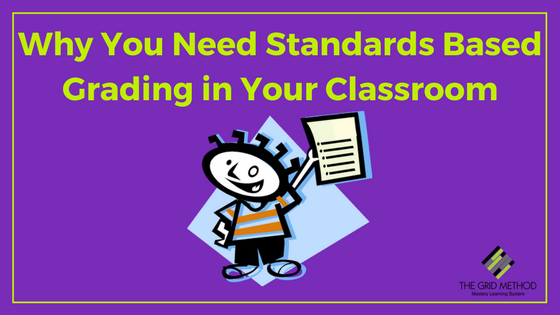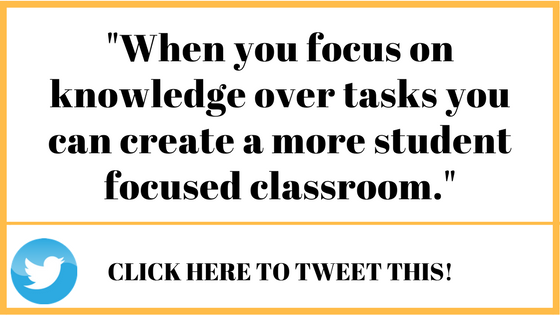Let’s Make This Simple: We can pretend that because we are teachers we should have autonomous and authoritative control over everything that goes in our grade books, and that we should get to decide how we grade, what our grade books look like, and what is represented in them. As you clutch your grade book against your chest protectively, I’m just asking a simple question. Does this really make sense?
If we are truly measuring student growth and knowledge of the standards or mastery of content, shouldn’t our grade books look pretty similar? The grade book, or representation of student knowledge, for all stakeholders, should be represented by a student’s understanding of the content covered in targeted competencies or statements that can be measured.
The truth is; I’ve seen so many different variations of how students are assessed, that grading tends to be something very few teachers can really agree on. I’ve talked a lot about what goes into your grade book, but there is a fundamental misconception about the reason we grade and the fundamental philosophy behind it. Through the decades, “grades” have become a letter representation or percentage representation of a student’s ability to play the game of school…not actual knowledge.
What is Standards Based Grading (SBG)?
Standards Based Grading is something that has become very popular in many schools I work with, and is honestly the closest thing to true grading and assessment of student knowledge I have seen. SBG represents a shift away from just putting dozens of test-grades, quizzes, and homework assignments into the grade book. Instead, we focus on identifying each standard or tiered learning target, based on standards, and then provide an assessment of whether a student can meet, exceed, or is still developing their understanding of that content. This is a fundamental shift away from “task based” grading. It takes the focus away from what the student is doing and allows the teacher to only focus on what the student actually knows.
Standards Based is Student-centered
More than anything else, when you focus on knowledge over tasks you can create a more student focused classroom. Instead of worrying about every blank being filled, or every answer being complete, you can focus on what the learner knows and does not know. Now, this is much easier if you are using a mastery based system and formatively assessing regularly, but even in traditional models the focus on knowledge over worksheets is always going to be better for your students.
The traditional grading scale also does a huge disservice to students.
The number just don’t add up. If you think of a traditional grading scale it might look something like this:
0 – 60% = F
61 – 70% = D
71 – 80% = C
81 – 90% = B
91 – 100% = A
Looking at this, what letter grade has the largest % of probability? In most systems, a failing grade makes up 60% or more of the grading scale.
This means two things:
- Students are more likely to fail than succeed.
- In that 60% of the scale that is failing, there is no additional information about why the student failed.
There is an additional problem with this scale in that from unit to unit a bad performance or low enough score (10 – 30%) could cause a student to have no chance (mathematically) to come back from a mistake.
This is also an out-dated and useless way to measure student achievement. It provides very little about what the student actually knows and causes the entire culmination of the students understanding to be summed up with a single number and letter. In no rational person’s mind should this make any sense whatsoever.
Let’s Recalculate…
Instead of the traditional scale, what if we replaced the 100 point scale with a 4 point scale or a letter scale that represents actual understanding the learner has.
Example:
1 – Unsatisfactory / Un-attempted
2 – Developing
3 – Meeting
4 – Exceeding
Within the example (and there are multiple ways to do this, I’m just trying to illustrate a point) this also begs a much more important question. What do each of these levels mean? There are dozens of important thoughts and discussions that a teacher using this has to have with both their colleagues and their students. For example: “What is ‘Meeting’ a standard as written?” If we are honest with ourselves, these conversations should be happening all of the time, but sadly that doesn’t seem to be the case. If this scale was being used in a grade book it might be listed like this: (Please forgive the simplicity of this example for the sake of illustration)
Standard Focus: States of Matter
Student can Identify all 3 states of matter = 4 – Exceeding
Student can apply understanding of all 3 states and determine what causes them to transition = 4 – Meeting
Student can compare and contrast the properties of substances at various temperatures and pressures = 3 Meeting
Student can predict and evaluate the state of a substance based on provided data and conditions = 2 – Developing
By looking at this example, a teacher, parent, administrator, or any other stakeholder (including the learner) can identify what they know, what they are still working on, and what information or content is needed to improve their understanding of the standard. The example above represents a “target based” approach to standards based grading. But even if a single numerical representation of the standard was provided through the assessment of knowledge and mastery, as opposed to a padded, miscalculated representation of many various assignments and tasks, it much more closely relates and conveys the student’s true understanding.
So as you start to think about your own grade book, consider what all those assignments mean, what those grades actually mean, and what you are actually representing. Does it make sense?
If a student understands or has shown mastery on all of their assessments, but is failing your class because they didn’t do any homework…you’re doing it wrong.
If a student can explain and show mastery on concepts, but they are doing poorly in your class because they didn’t turn in that one assignment 3 weeks ago…you’re doing it wrong.
If you’re grade book or system represents anything other than student understanding of standards and content…you’re doing it wrong. That’s not an opinion. It is a simple truth that I hope you already understand.




